

 CONTENTS GROWING UP IN TURKEY My father moved to Ankara to work when he was sixteen, and I was born there. As a little girl, I used to follow my mother, anne, around the kitchen watching everything she did, and first started cooking when I was about six years old. When she made flatbread, I would steal pieces of the dough and try to make a small loaf out of them. When she made biscuits, I would try to make a few on each tray. My father, baba, would come home from work and say, Are you still making biscuits?, which we made all the time. There were four children in my family, and we were very poor.
CONTENTS GROWING UP IN TURKEY My father moved to Ankara to work when he was sixteen, and I was born there. As a little girl, I used to follow my mother, anne, around the kitchen watching everything she did, and first started cooking when I was about six years old. When she made flatbread, I would steal pieces of the dough and try to make a small loaf out of them. When she made biscuits, I would try to make a few on each tray. My father, baba, would come home from work and say, Are you still making biscuits?, which we made all the time. There were four children in my family, and we were very poor.
Despite this we always ate very well. Two hundred and fifty grams of mince would last our family for four days. I remember being sent to the butcher to buy mince for the family when I was seven years old. I noticed the butcher ran the meat through the mincer twice, and when I asked why, he explained that it was to hide the fat. To this day, I closely watch the butcher to make sure hes not running the meat through twice.  Me, aged seven (top right), with my sister Gfer (aged twelve), brother Murat (aged five) and brother Ferhat (aged three) Most people in Turkey were poor when I was a child; we didnt know anything different.
Me, aged seven (top right), with my sister Gfer (aged twelve), brother Murat (aged five) and brother Ferhat (aged three) Most people in Turkey were poor when I was a child; we didnt know anything different.
My family are Alevi Muslim. We dont fast during Ramadan, we fast at a different time, Muharrem Ayi. During this time we would fast for two weeks. At the end of the fasting, families would slaughter a sheep or a rooster, depending on how wealthy they were, and then take the best portions to share with their poorest neighbours. At this time everyone would hold a feast for their family. If we had a sheep, Anne would smoke the legs and the head of the sheep to remove the hair, then clean and boil them, and make a soup with fresh garlic.
Every part of the animal would be eaten. We would fry the sheeps testicles, the kidneys and liver. The brains would be made into a salad, drizzled with lemon juice and olive oil. When I was a small child my father sold fruit and vegetables, similar to a wholesaler. Later he opened a caf, or kahvane. Only men were allowed in the kahvane, where they would play cards or backgammon and drink tea all day.
There was no food in the kahvane, just coffee, tea and apple tea (tarin). I would dress up as a boy and serve cups of tea. I was paid five cents a day for this work, but my brother and his friends worked there too, and they were paid fifteen cents a day. We didnt have access to clean running water from the tap we had plumbing, but the water would freeze solid in winter. An old man would deliver our water on a donkey every couple of days. He seemed very old to me, and I felt sorry for him riding along in the cold on his donkey.
One day I saw him at my fathers kahvane, so I took the donkey home to deliver our water myself and save the old man a trip. On my way I was stopped by a neighbour, who asked if this was the new owner of the kahvane. I said, No uncle, hes our new neighbour!  Anne and Baba in the 1970s The women in Turkey spent hours cooking, because everything was made from scratch even the filo pastry. My grandparents grew wheat, and my uncle grew vine leaves, and when they harvested we were given bags of this produce to last us through the winter. I remember Anne making baklava. First she would soak the wheat for a couple of days, and the sediment would collect underneath.
Anne and Baba in the 1970s The women in Turkey spent hours cooking, because everything was made from scratch even the filo pastry. My grandparents grew wheat, and my uncle grew vine leaves, and when they harvested we were given bags of this produce to last us through the winter. I remember Anne making baklava. First she would soak the wheat for a couple of days, and the sediment would collect underneath.
She would keep this sediment, which was very fine like cornflour, then dry it, and sprinkle it over each sheet of the pastry. The best baklava is still made this way; its a hundred times better than mine. We made flatbread in summer to be used during the winter. The breads were stored in stacks to dry out, and then when winter came we would sprinkle them with water and heat them through to eat. When I was about seven or eight years old, I started cutting out recipes from the newspaper and pasting them into a book. I filled the book with recipes and carried it with me for many years, even to Australia.
But when my house in Leichhardt burned down, the book burned with it. I was so sad. My grandparents all lived about four hours away in a little village near horum called Karkin Koy. I called my mothers stepfather Buuk baba. He sold animals for a living. One day when he came home with buffaloes, I was so scared that I hid.
My grandmother, Anneanne, would milk the buffalos he brought home and make yoghurt from the milk. She would boil the milk, then cool it. When she tested the milk with her little finger and it held for five seconds without burning her finger, it was ready. Next she would take a bit of the old yoghurt and mix it with the hot milk, then pour it back into the pot, stir it and put a lid on it. She would cover the pot with all the blankets and jumpers we had, for about eight hours, then uncover it and cut out the yoghurt with a knife.  Babaanne and Dede, my paternal grandparents, around 1980 Babaanne and Dede were my fathers parents.
Babaanne and Dede, my paternal grandparents, around 1980 Babaanne and Dede were my fathers parents.
Babaanne would make yoghurt from cows milk or sheeps milk, then put it into a yayik, a wooden cask with a lid and a little hole. The cask would hang from the ceiling like a swing. Babaanne would sit on one end and I would sit on the other, and we would rock it backwards and forwards until the butter formed on top. She would scoop out the butter, then wash it. We would have the butter on our bread, and drink the juice from the yoghurt. I remember one day when I was a child and we were having a picnic, Dede took a watermelon, cut out the pulp and made shepherds salad.
Its made with tomatoes, cucumbers, green capsicums (peppers) and olive oil. He tossed all the salad together and then piled it back into the watermelon shell. That was the only time I ever saw my grandfather cook. Dede had a seten, a big rock and wheel, used for husking the grain from wheat after harvesting. He would roll and smoke his cigarettes, then draw the horse through the fields. All the villagers would bring their grain to him, and he would grind it with the seten, to make cracked wheat.
Theres a black and white photo of Babaanne and Dede hanging on the wall at Beachwood. It was taken around 1980, and it tells a lot about life and people in Turkey even then. Babaanne is holding one of her pots of yoghurt, and Dede is smoking one of his roll-up cigarettes. They are dressed in coats, standing near a whitewashed house with a wooden doorframe. Dede is in front, scowling at the camera, with a lined face and a bushy moustache. Babaanne has a headscarf and is wearing shoes and stockings, with a beautiful wide smile on her face.
THE TURKISH MARKETPLACE Good Turkish cooking is all about the ingredients. When I was a girl, there was a little growers marketplace in our neighbourhood every Monday or Wednesday. My sister and I would walk from one end of the market to the other, chatting with the stall holders and buying our food for the next few days. One stall holder sold eggplants (aubergines), one sold potatoes, one had a stall with all the greens and tomatoes, another a stall with peaches, and so on. At the end of the line of fresh produce stalls were the spice stalls, then sardines and watermelons. Every neighbourhood in Ankara had a market.
Next page

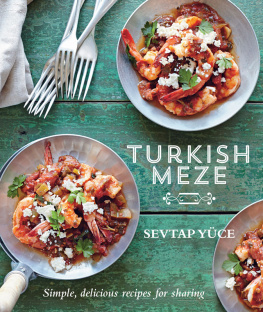
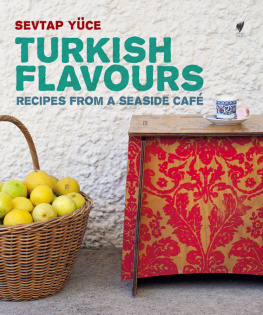
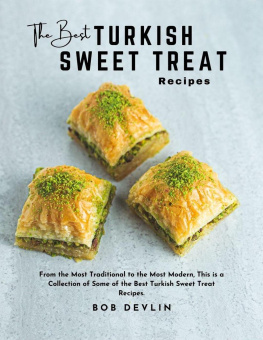
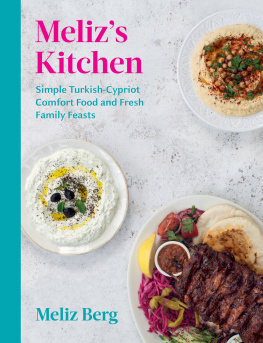
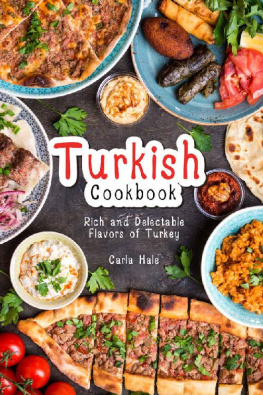

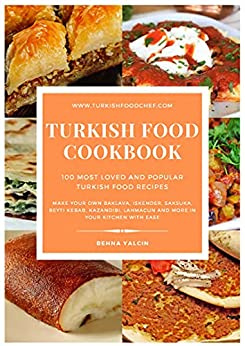
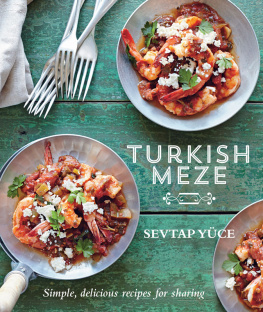
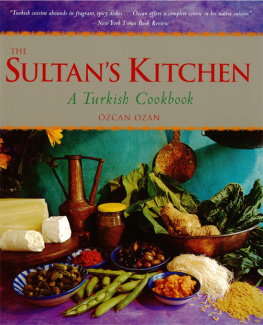
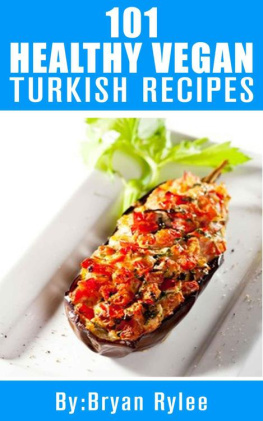
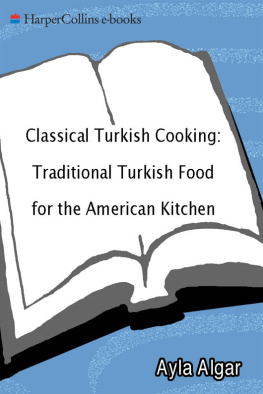


 CONTENTS GROWING UP IN TURKEY My father moved to Ankara to work when he was sixteen, and I was born there. As a little girl, I used to follow my mother, anne, around the kitchen watching everything she did, and first started cooking when I was about six years old. When she made flatbread, I would steal pieces of the dough and try to make a small loaf out of them. When she made biscuits, I would try to make a few on each tray. My father, baba, would come home from work and say, Are you still making biscuits?, which we made all the time. There were four children in my family, and we were very poor.
CONTENTS GROWING UP IN TURKEY My father moved to Ankara to work when he was sixteen, and I was born there. As a little girl, I used to follow my mother, anne, around the kitchen watching everything she did, and first started cooking when I was about six years old. When she made flatbread, I would steal pieces of the dough and try to make a small loaf out of them. When she made biscuits, I would try to make a few on each tray. My father, baba, would come home from work and say, Are you still making biscuits?, which we made all the time. There were four children in my family, and we were very poor. Me, aged seven (top right), with my sister Gfer (aged twelve), brother Murat (aged five) and brother Ferhat (aged three) Most people in Turkey were poor when I was a child; we didnt know anything different.
Me, aged seven (top right), with my sister Gfer (aged twelve), brother Murat (aged five) and brother Ferhat (aged three) Most people in Turkey were poor when I was a child; we didnt know anything different. Anne and Baba in the 1970s The women in Turkey spent hours cooking, because everything was made from scratch even the filo pastry. My grandparents grew wheat, and my uncle grew vine leaves, and when they harvested we were given bags of this produce to last us through the winter. I remember Anne making baklava. First she would soak the wheat for a couple of days, and the sediment would collect underneath.
Anne and Baba in the 1970s The women in Turkey spent hours cooking, because everything was made from scratch even the filo pastry. My grandparents grew wheat, and my uncle grew vine leaves, and when they harvested we were given bags of this produce to last us through the winter. I remember Anne making baklava. First she would soak the wheat for a couple of days, and the sediment would collect underneath. Babaanne and Dede, my paternal grandparents, around 1980 Babaanne and Dede were my fathers parents.
Babaanne and Dede, my paternal grandparents, around 1980 Babaanne and Dede were my fathers parents.